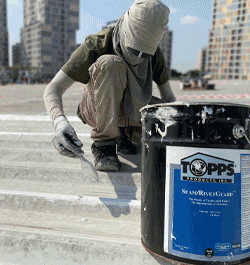UP TO THE MINUTE
The Coatings Recipe for Success - PODCAST TRANSCRIPT
February 3, 2025 at 4:00 p.m.Editor's note: The following is the transcript of a live interview with Nick Doran and Luis Ramos of MuleHide. You can read the interview below, listen to the podcast or watch the recording.
Megan Ellsworth: Hello everyone. My name is Megan Ellsworth, and this is a Coatings Talk from CoatingsCoffeeshop.com. And today we're talking about your recipe for success when it comes to coatings. Today's episode of Coatings Talk is sponsored by Mule-Hide, so thank you and I'm really excited. We have some incredible panelists today. We have Nick Doran and Luis Ramos. Hi gentlemen, how are you?
Nick Doran: Hi, Megan.
Luis Ramos: Hello Megan.
Megan Ellsworth: I am so excited to hear all your wisdom today. Our practice last week was so great and just really, I think this is a great topic. So we're talking about recipe for success. Luis, I'll have you introduce yourself first, just tell us a little bit about you and MuleHide.
Luis Ramos: Okay. Well, thank you Megan and thank you for setting this up and welcome everybody who's on the webinar. Yes, my name is Luis Ramos and I am the Southeast Florida Territory manager for MuleHide. I come with about 20 years experience in the roofing industry, most of it with ABC Supply where I started my career and then transitioned over to Mule-Hide in 2011. So I've been in the South Florida market for the past 14 years selling a wide variety of low slope products, including silicone, which is what we're going to talk about today. So welcome.
Megan Ellsworth: Amazing, amazing. Thank you. Welcome. Nick, how about you? Who are you?
Nick Doran: Yeah, like Luis said, thank you everybody for joining. Megan, appreciate you getting us on here. And my name is Nick Doran, like Megan mentioned, been a territory manager with MuleHide for just over six years now. I spent the first four of that of my time with MuleHide up in eastern Michigan, so I had a lot of cold weather and then getting into the summer, so a lot of fluctuation of temperature in regards to our product lines. And then about two years ago transferred down to Austin, Texas, which is where I sit today and sitting in the Territory manager role here as well.
Megan Ellsworth: Incredible. Yeah, that's a big weather fluctuation from Michigan to Texas.
Nick Doran: It is, yes. And I'm not, I don't necessarily miss the winters. Our winter here in the south is very brief, get a taste of what it used to be in my life and move on. It's a little bit of spring right now, to be honest with you.
Megan Ellsworth: That is nice.
Luis Ramos: Scraping the windshield with a credit card.
Nick Doran: That's it. I do not have a scraper in my truck. I'm not upset about that.
Megan Ellsworth: Awesome. I'm jealous. Okay, so let's start out with Hewnik. What about the roof coating space makes it such a valuable opportunity for roofing contractors?
Nick Doran: Yeah, it's a good question. And from a roofing contractors perspective, look at it if it's something you're looking to explore, it's another tool for the belt, as they say. Oftentimes with existing buildings, we're looking at roof restoration. A lot of times the mindset is a recover or a reroof maybe where we could, like I said, put a roof on top of the existing or we're talking a tear off with a fluid applied restoration. We're keeping all items intact, we're applying a monolithic system of fluid applied product and we're restoring the life of that existing roof there. So it's a good thing for the building owner, the contractor's client, it minimizes liability.
There's also minimal maintenance required once it's completed. And again, it's something that's another tool for the belt. You can diversify your portfolio as an installer. And in a lot of cases as a roofing and contractor, you can bring a multipronged bid approach to a project. One could be a maintenance and repair to get something dried up or dried in for a year to six months. It could be a coating option. And then from there, it could be a longer term tear off reroof, so it could be one bid with three different avenues including the coating.
Luis Ramos: Yeah, those are great points, Nick. And as a matter of fact, you mentioned the word restoration more than once and I think that is a key point for those of you who have clients that are looking at considering silicone coatings as an alternative to a full tear off. The question often comes up, is silicone considered a new roof system? And it technically is not. It's considered a restoration system, so that-
Nick Doran: Yeah, great point
Luis Ramos: ... can play. When you have an insurance carrier who is requiring, as we have so many cases here in south Florida, we're in a hurricane zone. Insurance carriers will typically not consider a silicone coating a new roof system. They will consider it a restoration system, but it still gives them the option as to whether or not they want to continue to ensure that building. In most cases, they will not accept silicone as a new roof. That's a full-blown tear off, but otherwise it is a great option as opposed to a tear off or a recover. But it is at its core, a restoration system.
Nick Doran: And Luis, that comes into play, like you mentioned in a situation where there's two roofing assemblies that already exist on one building, most building codes don't allow a third in that case, but this a fluid applied restoration system, silicone or whatever chemistry honestly is chosen could go on the top layer. But ultimately it's two roofing systems that exist, throw a coating on top of there and that's within codes for most municipalities.
Luis Ramos: Right, right.
Megan Ellsworth: Wow. So Luis, what would you say are some of the differences between a coatings' restoration job and other roofing jobs?
Luis Ramos: Well, Nick already touched on one, you're minimizing liability when you're not doing anything structurally. No tear-offs, it really speaks to a significant cost savings to the client, to the contractor because there aren't any dumpster fees, there aren't any risks and exposing what's inside the building to anything being done on the roof. So that is a big part of it. Because we get asked this all the time that on average the cost of a tear off is about twice the cost of coating a roof system with virtually zero liability. So that's a significant savings. When the roof is a good candidate for coatings here at MuleHide, we have to approve and want to encourage contractors to call us, whether it's a warranty or not, because we don't want our contractors to ever want to put good over bad. And so being able to make sure that the roof is a good candidate is key.
Again, minimizing liability for the contractor and the building owner, it doesn't disrupt anything that's going on inside the building. It is a very environmentally friendly system. You're not filling up more dumpsters and creating more mountains of material that's being dumped into surrounding areas. It is a very energy efficient system. Silicone has some really unique properties in that it distinguishes between water as a vapor and water as a liquid, so the roof can actually still breathe, which is important for any roof system without allowing water in. And then at the end, it really significantly slows down the aging process of the roof. We coat a variety of roof systems. The most common is a granulated, modified bitumen system that is an organic system and you're basically arresting the aging process when you coat the roof. So tremendous advantages to using coatings for that type of job.
Megan Ellsworth: Yeah.
Nick Doran: And Lou, you being down there in South Florida and myself here in Texas, the reflectivity obviously is oftentimes these coatings are put down in a color of white, I would say is most common. It would have the option for other colors, but the reflectivity and then also the ability to cool, actually cool the surface that's being applied to. So it does help the heat transfer. I mean, it's not so much as an R-value approach, but ultimately it can, from an energy efficiency standpoint is where I'm going with this. It does help in this case, in those hot areas, it does help with the-
Luis Ramos: No question
Nick Doran: ... energy efficiency of a building in terms of running the air conditioning constantly,
Luis Ramos: Especially when there's a steel or wood deck present. Even with insulation now, concrete's six, eight inches of structural concrete. It's a pretty good insulator. So the energy savings may be minimized by that, but in every other case, it could significantly save energy costs.
Megan Ellsworth: Which is such a huge sales point for contractors with building owners. Everybody wants to be more sustainable, save on energy costs, save on electricity costs and natural gas. So I mean that within itself is a great selling point.
Nick Doran: Absolutely. Yeah.
Megan Ellsworth: Okay, so okay, there we go. Nick, what are some costs going off of that contractors should expect upon entering into the coatings world?
Nick Doran: I would say it's accurate, really right out of the gates to say the barrier of entry into the fluid applied category, coatings category, whichever term you'd like to choose, is pretty low. Barrier of entry is pretty low. Oftentimes these projects are being installed with nothing more than an extension pole, a roller flank, a roller frame and a three-quarter inch nap roller, perhaps some squeegees, but that is about it. Maybe some chip brushes or something of that nature.
Megan Ellsworth: That's awesome.
Nick Doran: There is some actual equipment that an installer can invest in, some spray equipment. There's even kind of a middle ground. There's some spreaders, kind of a larger roller I would say that you pour material into and you can spread it out in a wider area in one pass, but ultimately it not a major investment. I think anybody who will take the time to get the training, which is the second point here, can really do some damage and have one heck of a business model using minimal amounts of equipment and a minimal cost there. Training, more times than not, I mean, mule height is a manufacturer. There's other manufacturers out there, training's often free of charge. It's really great and taking the time to invest in the training, I think, Lou, you may be able to attest to this, a lot of contractors want training and then oftentimes the training time comes and they're rushing you out of there.
Okay, when are we done here? There is an investment here. This is all about coverage rates. This is all about a recipe in which to properly install this product line, these product lines. So understanding how to do it is the most important thing. And I tell you what, Lou would be very upset if I didn't discuss the most important piece of equipment, which is this little guy. If you can all see, this is something that many manufacturers can provide to you. This is a wet mill gauge. Regardless of how you install these coatings, measuring the amount of product is key to the success in this little tool.
This is a wet mill gauge speaks for itself from the standpoint you use this when the coating is wet and it has various teeth on this thing that each tooth is numbered. And for example, in our silicone specification, in a ten-year system, we want 24 wet mills applied per square. So I find my tooth, that's number 24, I dip it down into the wet material. If that 24th tooth has material on it, I know I have enough product. That alone that's using a roller, a squeegee, this little guy here, that alone is, you're setting yourself up for success there.
Luis Ramos: Great point, Nick. Great point.
Nick Doran: Beyond that is of course the materials. This is a multiplied restoration system, system essentially, meaning there's multiple components to properly do this, oftentimes there's a cleaner. We have to clean this membrane. Lou loves this line where coatings don't stick to dirt. It's the same concept as you don't take a shower without soap, right? So when we clean these roofs, we want to use a cleaning solvent and then depending on the substrate, there may be a primer needed. There's a sealant, kind of like a mastic, get this thing dried in seal, the seams up, corners, penetrations, pipes and then finally the coating. The coating is truly the last step. It's the step I think that gets the most discussion on, but I don't want to say it's the least important, but the coating is only as good as the prep work, prep work that we just discussed before that.
Megan Ellsworth: That's a great note.
Luis Ramos: And there lies the rub when it comes to equipment. As Shakespeare once said, because virtually anybody can get into this by buying a roller, attach it to a stick, a squeegee and a couple of chip brushes. Literally about an hour before this call, I got a call from, he referred to himself as a do-it-yourselfer. I did my best. This is a homeowner who wants to coat about five squares in the back of his house. I mean, Nick and I get those types of calls. We strongly recommend they contact a contractor professional to do it. But that being said, beyond that, it makes it very easy for virtually anybody to do this. So without the training, without professional advice to be able to do it correctly, it could be just putting money over bed,
For anybody out there that is thinking about taking lessons to play golf. I'm a terrible golfer, but I enjoy playing. We used to say the same thing in the golf industry, and that is spend the least amount of money on equipment and put the rest of it in lessons. Very similar idea here. You're not going to spend a lot of money on the equipment to coat a roof unless you buy a pressure sprayer, which in most cases it's applied with a roller, a squeegee, couple of chip brushes and that's it. So the investment is minimal, but the danger is that virtually anybody can do it and very quickly do it incorrectly and waste that investment. So very important to get the proper training and also to contact the professional to do it.
Megan Ellsworth: Yeah. I also loved what you said Nick and Lou about it won't stick to dirt. That's so true. And you mentioned before the call, it's allergy season in Texas, so there's pollen flying. Even if a surface looks like it might be clean, going through those proper steps and channels to make sure it is clean just ensures an even better end product. If there's just a little bit of pollen under there, you want it to have a great life and a long-lasting life. So I think that was a good point too.
Nick Doran: Oh yeah, absolutely.
Megan Ellsworth: Okay, so Luis, how can roofing professionals effectively train their team, maybe even homeowners, to develop the skills needed for this coatings work?
Luis Ramos: Well, the manufacturer is really key in this because in most cases, certainly at Mule-Hide, we really take a lot of time in training our contractors and Nick mentioned that in most cases it's free. In all cases it's free with MuleHide, we encourage contractors taking the time, whether it's walking the roof for an hour or going to one of our training seminars for maybe a couple of hours to get the proper training. We encourage the contractors, or typically the owners or perhaps project managers to bring the actual applicators, whether it's a subcontractor or someone in-house to bring them to these trainings so they can see and hear firsthand the sequence of how things are applied. And not only do we focus on how much is applied, but there's also timing issues. We want to be able to allow the material to cure properly before going on to the next step.
Or as in the case of the cleaner, we want to make sure that the roof is dry and cleaned before we go to the next step, be it primer or details or whatever. So the best way to set the expectation of getting a good result is simply to get the foundation to get the training, whether it's on the job training that Nick and I provide or at a seminar and I think that way we minimize the risk of doing something that's going to cost more money and more time later. Couple of quick bullet points, Nick, you might want to address those, starting with assigned roles.
Nick Doran: Yeah. And this is really on the job here. This is you're getting ready to stage a roof to actually apply the coating assign roles where there's individuals accomplishing something at the exact same time. From mixing the material, we have to set the material and get it ready to actually be applied out onto the substrate. So having somebody with a mechanical mixture, using a screw gun with a mixing tip, stir these things up, they do need some mixing and getting those ready, that's a step right there. Having that outlined, having that person, that defined role is probably what I'm trying to say here. Having that outlined is building efficiency into the business model quite frankly.
From there, we already talked a lot of what we're talking about here from terms of coating is the amount of roof coating per square. So measuring the area grid, your roof or take a small amount of the physical coating and you can even, I'd hate to say the word paint because we're not painting a roof in any capacity here, but essentially drawing lines with the physical material to indicate the squares on the roof. And then of course, we talked measuring the thickness. How much are we actually putting down per square? Document it. This little trusty guy that I already showed you is your best friend using this, documenting the amount per square, taking pictures of that is all truly needed for success in this space.
Luis Ramos: I was on a pretty big job about a month ago before the holidays where it was our second visit back to the job, and we were going over some punch list items as a result of the inspection and the crew, which I'm pretty sure was a sub, I'm not sure if they were the original sub crew or not. Anyway, I showed up to the job site and they were mixing the material with a half inch PVC pipe that is never going to get the right consistency that we need in order for the material to what we refer to as vulcanize painters are notorious for using an excessive amount of material because unlike silicone acrylic, vulcanizes or thickens differently.
So as a result of that, they tend to use much more material when it's not needed. Silicone has this unique property of linking together the chemicals in the silicone link together to thicken or solidify the material. So really staying within the coverage rates for whatever amount of time, 10, 15 or 20 years. It really comes down to trusting the process and trusting the material to do what it can do by properly mixing it.
Megan Ellsworth: Wow, that's interesting. With PVC pipe. Holy cow.
Luis Ramos: No judging, but-
Megan Ellsworth: Absolutely.
Luis Ramos: ... quickly stress the importance of making sure that they have a mechanical mixture, whether it's to start the job or to end the job.
Megan Ellsworth: Yeah, no, for sure. I like that you both really reiterated it's not painting.
Nick Doran: It's not painting.
Megan Ellsworth: It's really much more, I wouldn't say intensive, would you say intensive? Or maybe just it's different, right?
Nick Doran: It is. It's different.
Luis Ramos: It's different.
Nick Doran: It's different. I mean, you're prepping a substrate that's been exposed to the outdoor elements and this is kind of bringing it all into one bucket. These are different regions, these are different temperature restrictions and a lot of situations that painters don't have to deal with. And I say that because you kind of took the words out of my mouth to a degree where I get questions a lot in terms of going after painters to train them to become roofing installers of fluid applied systems.
Megan Ellsworth: Interesting.
Nick Doran: I guess I've seen a little bit of success, but ultimately the people doing this and Lou, you can dive into this if you want as well, there should be a knowledge of best roofing practices as well.
Luis Ramos: Yes, absolutely. That foundation really goes a long way, whether you're installing a TPL roof, a modified roof or a silicon roof, there are just certain basic best practices that take place throughout that. The weekend warrior or do-it-yourselfer is just not going to understand or likely to follow. So it's an important-
Megan Ellsworth: Absolutely. Absolutely. I just want to reiterate too, to everyone out there listening and watching, thank you for being here and the chat is open. So if you have questions for Lou and Nick, please throw them in the chat or just say hi. Let us know where you're zooming in from today. Okay. So, Nick, back to you. What should contractors look for when they're assessing a roof before starting a coating project? Yeah,
Nick Doran: Yeah. I mean, first and foremost, we need to get out to the job, okay? There's a lot of technology in today's world. You can accomplish a lot from Google Maps. I get that you can accomplish a lot with drone technology. I also understand that I'm not saying get away from those practices, but getting out to an existing building, getting up on that roof safely. Safely, and if you climb up a ladder, tie it off, the last thing you want to do is get stuck on a roof because your ladder blew down. But ultimately, first and foremost, you get on that roof, you do a visual inspection. The roof is going to tell you a lot of things. If rain came through recently and it doesn't have a great slope, there may be water standing there. Especially here in Texas, if rain hasn't come in a while and it's been nice and warm and sunny, you're going to see a lot of staining on that roof where water has historically collected up there.
So you can identify slope in a lot of cases before or after a rain event. So understanding what that looks like from there, we're starting to look at just visual damage. Are there any blisters? Are there cracking? Are seams opened up to the point where they're trying to talk to you, right? They're blowing in the wind. Are wall flashings still hung or do they look like they have delaminated essentially, meaning they're no longer stuck to the structure that have been flashed in the past? So understanding the condition of the roof. Ultimately we want to make sure that this roof is still sound. What I mean by that is if there are leaks, we want to identify the leaks and if those leaks have caused any type of moisture or saturation within the roofing assembly, we need to identify where that moisture lands. Is it just in the spot where the leak is and it goes directly into the building?
We found the leak, let's fix it. However, if that leak has allowed the moisture to spread throughout the roofing assembly, we need to identify how far that's gone and get rid of that. Because at the end of the day, the last thing we want to do, whether it's a new roofing assembly or a fluid applied coating, is we do not want to trap moisture in any case here. Okay. Exactly. And then the final step is let's say everything that we talked about is good. It's dry.
There are some repairs to make. We've determined that this is a candidate that is a good term, determining candidacy for a coating. The last thing we need to make sure is our coating actually going to stick to this substrate. At the end of the day, we're only as good as what we're applying this coating too. So we can do a process of an adhesion test. And there's several videos out there. MuleHide has some good resources from an adhesion test video that walks you through step by step. Lou, I'm sure you've been out there, but it's something we can help a roofing installer do, but ultimately we need to make sure that our coating is going to stick.
Luis Ramos: Absolutely. Absolutely.
Megan Ellsworth: Yeah.
Luis Ramos: And Megan, that's a beautiful picture of a modified roof system, which we also make that looks like it was installed yesterday. They almost never look like that when we're at the roof. And to Nick's point about existing slope or positive drainage, you can have a roof that has good slope, that has positive drainage and still have potential ponding areas. There are what we call the low areas typically around drains or maybe around scuppers or just over time where insulation has what we call undulated, kind of like the greens at Augusta National. There's undulations that could actually hold water to the degree that it could cause roof failure. And another point that Nick made is walking the roof. You can't tell from a photograph whether there are blisters or not. You really have to-
Megan Ellsworth: Feel through.
Luis Ramos: ... feel your way through that roof system because any separation of membrane to substrate is an issue and could cause down the road roof failure. So it has to be repaired typically with light materials and before proceeding with the cleaning and coating, et cetera. And then the last thing about adhesion that I'd like to make, it's important on any roof system, but especially with TPL, nothing likes to stick to thermal plastic. So we offer a primer that promotes adhesion. And so for Nick and me, we always get our spidey sense up when we're going over coating to TPL because it can be very finicky. And using the right primer and the right amount of primer would be important when sticking to TPL.
Megan Ellsworth: Yeah, absolutely. Going back to coatings don't stick to dirt.
Luis Ramos: Yes. They don't like the thermal plastic either, but they will. Or any single ply with the right primers.
Nick Doran: And I want to jump in real quick here. This is something that actually came up after we talked last week, and I'm here in Texas. Hail, the presence of hail is common enough that we deal with it. There are membranes out there, other thermal plastic membranes, different three-letter membranes start with a P PVC that when aged and they get hit with hail, they can be very brittle and they can spider crack similar to a pebble or a rock hitting your windshield when you're driving down the road. And I get the question all the time, is this a candidate for a coating just because of the fact that it's a PVC membrane? In a nutshell, PVC could accept a coating. However, a hail-damaged PVC is a tough thing to handle because the first step of any coating system is a pressure wash. So if you have cracked and hail-damaged PVC, you're now introducing water into the roofing assembly.
So then I get the follow question, well, can I go ahead and patch all those areas that I can see in theory? Sure. But if you can identify all the areas that are cracked up, and again, I say PVC because it seems to be the most common substrate that that happens to, but this could be a TPO situation and beyond. So I would say this, and this is my opinion and Lou, if you have anything to say, but hail-damaged roofing assemblies, could they be coated perhaps just keep in mind that manufacturers may not be willing to offer a warranty on that system.
Luis Ramos: Yeah, that's a great point. And we don't have a lot of hail here in Florida. It does happen on occasion. The two substrates that we do have are what's called a grain-lidded roof system. We do not allow, nor do we recommend the coating of a grain-lidded roof, meaning not granulated, but gravel roof should say yes, because like trying to coat the moon, right? You're not going to get every little crevice and every little nuance to properly seal that area. So a gravel roof is not a candidate for a coating. And the other one that we can think of, which isn't around as much, but you'll still see it, are aluminum coated roofs, aluminum coating, we'll talk about it in a minute as something that we might see. Silicone will not stick to aluminum, it'll stick to acrylics, it'll stick to itself aged silicone, but not to aluminum coating. So those are the two that don't bother with an adhesion test. We're not going to let you coat anyway.
Megan Ellsworth: Perfect. Okay. So Nick, or actually, sorry, Luis, what are the different types of roof coatings and how can these contractors determine which system is the best fit for each particular project?
Luis Ramos: Well, yeah, I mean, there are lots of options in coatings. The best options are the ones that are not really available to the weekend warrior or the do-it-yourselfer. Going to a distributor where professional roofing contractors purchase their materials because they're going to be of the highest quality to use climate. That middle point is really important in terms of determining which coating to select. Here in Florida, we have a lot of moisture. We have a lot of trap moisture. There's moisture in the air. Silicone is the most popular choice for coating a roof system.
On the other hand, in places like Arizona where they have very little moisture, acrylics are very popular. They're not the same cost. The application rates are slightly different. They do require cleaning and primers and sealing, etc. But it really does, it is dictated by the particular area that you're in. Nick would know more about what happens in the southwest and where it might be a toss-up between acrylic and silicone. But in our market here in Florida and areas like it, Silicone is really king. Why? Because it performs better under the kinds of conditions that we see here with rain and moisture.
Megan Ellsworth: Yeah.
Nick Doran: Yep, absolutely. And my territory is a little bit unique in the standpoint that I do go down to coastal areas like Lou and higher humidity and silicone with the presence of moisture does cure better, and it's a moisture curing product. So humidity actually helps it. But yeah, you hit it right on the nail there.
Megan Ellsworth: Awesome.
Luis Ramos: If you look at that first bullet, pounding water equals silicone. What that does not mean is that, hey, any pounding water condition you bring to the table, silicone is going to be the answer. Silicone coatings, like most coatings are not a miracle in a bucket. Water up to your ankles, nothing is going to help that. But to the degree that we can assess and possibly repair any of those ponding issues, ponding is defined as any standing water more than 48 hours. We can do those repairs and really promote water not moving away from an area where it's holding too much water. So I wanted to make that point, Megan. I didn't want people to think that, hey, silicone is going to cure all sins with ponding because it has limitations.
Megan Ellsworth: Right? Yeah. Just like any product, absolutely.
Luis Ramos: Like any product.
Nick Doran: And you kind of touched on that for a second. You sparked something there, Lou, because it goes back to making sure you get a professional out there. If that situation arises where you walk on a roof and it's got ankle-deep water, it should take an experienced person to have that conversation with the building owner or homeowner in this case and say, we need to think longer term beyond a fluid applied or a coating here. This is not a candidate for the presence of water. And really the issue of the water in that case is the weight on the structure. Nine times out of 10, that structure wasn't built to hold that amount of weight. Therefore, we need to develop a roofing assembly that actually is getting water off the roof. So thinking of a re-roof more than likely with a tapered insulation package. So Lou, yeah, you kind of hit it there, but that just struck a chord with
Luis Ramos: Me. Nick, how much does a gallon of water weigh?
Nick Doran: You're going to tell us.
Luis Ramos: It's about seven pounds.
Nick Doran: Okay.
Megan Ellsworth: Oh, wow.
Luis Ramos: So that's a lot.
Megan Ellsworth: Wow.
Luis Ramos: That's more than a gallon of milk. So it can really wreak havoc on the structural integrity of a wood deck to a lesser degree steel to a much lesser degree concrete, but it's never good. And there are simple, very cost-effective ways of being able to address those issues, including during the first and only pass to put more silicone, maybe another 15, 16 mils in what we call the low areas is anything less than 48 hours is considered standing water. We can address those areas very simply by just applying a little bit more silicone in those areas. And those areas are typically drains, scuppers, maybe around penetrations, maybe in the inside of a pitch pocket of an AC stand. Those are areas where they can capture and hold water for a longer amount of time than what we would like.
Megan Ellsworth: Yeah, absolutely. Wow. Those are some really great tips. I hope everyone out there has taking some notes. So Nick, why is... Going all the way back to the beginning points here, why is surface preparation such a critical step in the coating process and does proper preparation look like?
Nick Doran: Yeah, surface preparation is key. The success is in the preparation doing everything properly. The steps is what I'm getting at. Doing everything properly before you even apply any coating is the recipe for success. So again, nothing sticks to dirt. We have to make sure that these substrates are clean, they're clear of debris, any contaminants, a lot of commercial buildings throughout the country, again, I spent a lot of time in Michigan. There's a lot of industrial areas, there's a lot of manufacturing going on. There's liquefied chemicals that land on these roofs.
There are powdered substance that land on roofing substrates, but any of these chemicals can actually affect adhesion of a coating. So making sure we're clear of all those type of contaminants. And going back to what we mentioned earlier as well, everything that you need to properly do a coating system, especially through the MuleHide line is supplied to you. We have the cleaner, the one 15 cleaner. It's a ready-to-use cleaner out of the bucket. The way to apply it is you put it into a low-pressure pump sprayer, similar to the pump sprayer that you kill the weeds in the driveway is what I like to tell people.
And there's coverage rates to that quarter-gallon to a half-gallon per square. Let it sit on the roof about 15 minutes and then pressure wash it off. Okay. So it's there to help you prepare that substrate properly. But really before any of that, I guess I'm kind of going out of order here before any of that. It also goes back to that visual roof walk is making sure if we need to repair this roof, we do that. We stop leaks, we repair the roof, like Lou said with materials, get it to the point that we can apply pressurized water and we're not introducing moisture into the roof.
And then really, we talked about this already, but if there is presence of moisture, we have to get it out of there. And that's yes, coatings, but that's also, if I was talking TPO sitting here today, we never want to trap moisture. Ultimately, if we trap moisture, that moisture over the course of time is still going to attack something, it's going to go up and attack the roofing system or it's going to go down and attack my structural decking. And a coating world is probably going to go up and you're going to start to see bubbles and bubbles are no good. Of course. So surface prep is key. It's huge. It sets you up for everything.
Luis Ramos: Yes, and I can't overemphasize the use of a cleaner. In our case, we call it the A115 ready-to-use cleaner. It's an alkaline, so it's nothing toxic. Don't let it splash back into your eyes. It is an irritant, but it's also a degreaser, much like the orange stuff that we see sometimes to wash our hands with where it cuts through grease and dirt, it is probably the least expensive component of the whole process. And the ones that contractors like to eliminate, they'll either use water, which doesn't do anything. It's like taking a shower without soap, or God forbid they'll use chlorine that is toxic and it gets in your lungs and eyes.
It could be more than an irritant. So for God's sakes, do not use chlorine to clean the roof, but use an alkaline cleaner like our A1115, which is safe to use. It's the runoff is not going to damage any plants or bushes below. It's very safe and it will turn a dirty 20, 30-year-old roof into a relatively pretty clean, I mean, it's several shades difference. You will see the difference, and it's so important to promoting that adhesion that Nick is talking about.
Nick Doran: On top of that is also using the cleaner in pressured water. Some cleaners leave behind a film where you apply it, you maybe squirt it down with a garden hose. It may look cleaner, but the cleaner itself may have left a film behind. So that's why we say we use, in our case, one 15 cleaner and then a pressure washer. So all those things are important.
Luis Ramos: I'm getting one of those T-shirts that say nothing sticks to dirt. And then the MuleHide logo.
Nick Doran: I'll take a large.
Megan Ellsworth: I love it.
Nick Doran: I'll take a large,
Megan Ellsworth: I love it. We need another one that says why take a shower with no soap? I love that saying.
Nick Doran: Exactly.
Megan Ellsworth: Yeah. Yeah, it's so true. It's just so accurate. You can take a shower without soap, you can scrub as much as you want, but there might still be some grease and grime on there. Absolutely. Good.
Luis Ramos: And I think shout out to Mark Wessinger. I believe that's where I first heard that. So if he's on there today.
Nick Doran: He is the author.
Megan Ellsworth: Shout out, Mark. Okay. So Luis, how can contractors ensure that they're following the specific application instructions correctly and why would you say following those application instructions is so vital?
Luis Ramos: Well, it's all about the end result, right? It's all about delivering to the client what we promised them in a restoration system and the correct equipment, I mean, you're looking at one piece in your photo. It's simply a three-quarter inch nap roller, the chip brush that Nick mentioned. We use that for our details because we do require that all of our penetrations, scuppers waterways, drains that they be hit with our sealant. We have a couple of different sealants that we offer being able to measure the thickness because if this is involved in a manufacturer's warranty, like commercial projects for example, being able to have that gauge on hand, that what film gauge to make sure that we're getting proper thickness and applying the correct amount.
And then teamwork, it is a coordinated effort. We typically will see maybe three or four members of a crew on a job. One is doing the mixing, one is doing the prepping of the roof. One may be doing details because typically depending on the size, the job may be done in sections. And so being able to work together as a unit is very important to the ultimate result. So if the goal is to deliver the product that was promised, then I think following these very simple steps, not overestimating the importance of prep work, it can give that desired result and a reliable roof system that will last 10, 15, 20 years or more with minimal maintenance.
Megan Ellsworth: Absolutely. So we have a quick question that just came in from Matt Emerson. Do you have any methods to check dry film thickness?
Nick Doran: Yes. Go ahead, and I'll jump in.
Luis Ramos: Oh yeah. I mean all of our inspectors carry, it's a little machine that actually where they can peel away a piece of the silicone and actually put it in their gauge and it electronically measures the thickness right down to a single mill. So there is a very reliable, I mean, it's not an inexpensive tool. I don't know how much they cost, but they're not like $30. No, but they are something that our inspectors do carry around with them whenever there's a question about thickness. And that's typically done during the course of an inspection when there's someone on hand to be able to quickly repair that area in case they had to cut something away.
And one other point that relative to thickness, there are some roof systems particularly modified that will absorb more silicone in some areas than others. So even though we tend to look at a roof system as uniform, its going to be, if it's a twenty-year-old roof, it's going to be the same 20 years here as it is over there, but in certain areas of the roof, it actually could absorb more than others. So if that's the case, and even though you pre-measured the amount of material going on in that area, using that wet film gauge is important because we want to make sure that if the roof system is absorbing more, that we are adding more as needed to prevent possible problems down the road.
Megan Ellsworth: Absolutely. Nick, did you have anything to add on that?
Nick Doran: No, I mean Lou kind of hit it right there as far as answering that question with our inspectors, I guess to speak on the other side of the coin is if this was a non-warranted project, the Mule hide tech rep would not be out there. So what can a contractor do in that case? And there are some gauges that are available for purchase. I mean, you can go online and get them. I mean there's some that you, and I'll try to do it because the camera, you kind of hold it up to your eye and you look through this, it's almost like a little magnifying glass and you hold up the little piece of coating that you peeled out, you actually have to do, I'll call it a destructive testing where you do take some of the dry coating out, you hold it up.
And when you look through this little device here, and I don't recall the name off the top of my head, but as you look through it, there's little gauges that you can adjust it to in a 10-year system. For Mule Hide, specifically speaking, we're putting 24 wet mills down, which are going to cure to 22. So there's a gauge in this device I'm referring to that has a number 22 with these little T-bar, and it's kind of hard to show you, but ultimately that piece of coating needs to land within those T-bar number 22. So that's probably a pretty bad description. But ultimately the theme is this. There are some things out there beyond what Mule Hide has. We have some good stuff, some high end stuff, but there's some other stuff out there that contractors can get themselves.
Megan Ellsworth: Got it. Someone put in the chat optical comparator, is that what you said?
Nick Doran: Appreciate it. Thank you. I would not have said that.
Megan Ellsworth: Awesome.
Nick Doran: There you go.
Megan Ellsworth: Perfect. Well, we do have another question in the chat, but before we get to your question, Kyle, Nick, we have one last slide and then we'll get to questions. So where else if the slide will change? There we go. Where else can contractors go to find more resources to help them break into the coding space?
Nick Doran: Well, I mean, first and foremost, you're talking to or you're listening to two Mule Hide Territory managers talk to you today. So number one, thanks for the time, but lean on us. This is what we do every day. We pride ourselves on being available, getting us out there. Call us when you're getting ready to look at a roof. Schedule a time for us to join you. Let's walk, let's talk. Let's have this concept where whether it's myself or Lou, we're one of 40 plus of territory managers throughout the entire country. Presentation from a MuleHide perspective. So regardless of where you're listening in from, there's someone nearby that that will do exactly what Lou and I are talking about today, but getting a fresh set of eyes. And again, we have the technical knowledge with us. We understand these systems, we understand how to apply either of our chemistries regarding acrylic or silicone and then depending on what substrate it is, there might be a slightly different approach.
Know TPO from Modify that Lou and I talked about a few times today. So leaning on your resources at the end of the day from there's digital resources available to you, the MuleHide website, www.mulehide.com, right? Pretty simple. We have product data sheets for all of our products. We talked through this at length. This is a system fluid applied restoration system that requires multiple components. Talking about specifications. We have specific specifications for the chemistry in which you're choosing and the substrate in which you're coding too. And it's a written step-by-step recipe. From there, we have videos. I know there's a lot of people like myself. I'm a very visual person and YouTube is oftentimes my best friend. So we do have some videos that live out there. One thing that's not listed here, and I don't know how, we didn't talk about it the other day, but on our website under the resources tab, we do have a silicone coatings calculator to assist-
Megan Ellsworth: Oh.
Nick Doran: Yeah To assist you in doing a material takeoff. This is silicone specific and it's listed as that in the description, but it requires very minimal information. What are we coating over? Modified bitumen, TPO, PVC, it asks about the job size. Are we sealing the seams up, which is a yes or no question? I always say, yes, we want to seal this thing up and get it watertight. And then it asks for the warranty or the system, a 10, a 15 or a twenty-year system in which we're applying, because again, the amount of product per square dictates the warranty term in this case. So again, that lives on our website under the resources tab. It's called Silicone Coatings Calculator.
Luis Ramos: Awesome. I'm glad you brought that up, Nick, because you can literally, if you're a contractor and you're standing on the roof with your client or you want to discuss the scope of work with your client, you can literally be on your roof with your device and provide an estimate of the amount of materials that you're going to need depending on 10, 15 or twenty-year system. It will calculate it instantaneously. As soon as you plug in those four parameters and hit submit. You have a materials list both in gallons and in pails of how much cleaner sealant, primer and coating is needed for that specific job. And it already adds 10% waste factor because there's always a waste factor on a bucket that's sitting wide open to the elements and it already includes in that. So it's a really neat, simple tool that anybody can access 24/7 on the MuleHide website.
Megan Ellsworth: Wow. Hey, that's huge. I'm so glad you mentioned it. What a great tool to have at your disposal. And then also, I'll just finish this up. You can also find more information about MuleHide and everything they offer training-wise on the Coatings Coffee Shop website under the MuleHide directory, which is the photo that's on the slide. Really quick before we run out of time, I want to address Kyle's question from the chat since this is our question time and that is, what age of EPDM do you consider the cutoff for a good candidate for coatings? How old is two old?
Nick Doran: Lou, do you mind if I take this with my Please do. Yes. Up north. So I don't think there's a cutoff in age. I still think it depends on the true condition getting up there. I mean, I've been on 25 plus year reinforced EPDM roofs that were in really good shape. They were maintained extremely well over the course of that 25 years. The annual maintenance that happens on any given roof is really what can stretch the life out. So I don't think that there's a blanket statement out there. It's a case by case situation, especially with EPDM. If it's the old-fashioned approach where it was all splice adhesive, they didn't have any seam tape in the seams themselves, those often fail a lot earlier than those systems that did incorporate the tape. So kind of speaking out of both sides of my mouth here, but I don't think it's a magic number. I truly think it's something you got to get out there and evaluate the condition.
Luis Ramos: Yeah, Nick, you're right. I mean, we don't see a whole lot of black rubber here in Florida EPDM that is, but it's really more about the condition of the roof than the age of the roof. For example, we know that silicone will stick best to age silicone as opposed to new silicone. Going back to that potentially trapping moisture when you go back a week after you completed the job and try to go over some of the low areas so you don't get as good adhesion on going to new silicone. So we'll always talk about age silicone or making sure that the substrate is in good condition before coating it.
It's more about the condition of the roof than it is about the age of the roof. We routinely coat roofs, and if I had to put a number to it, I think his name was Matt, I would say the sweet spot and every roof is different, but the sweet spot is around 18 years, 18 to 20 years. Once you get to a point of 25 to 30 years, that's more than likely a candidate for a tear off and not a candidate for a coating. All things being equal, that does vary, depend on its condition, but it really is more about the condition of the roof system itself than about the age.
Megan Ellsworth: Absolutely. Great answers.
Nick Doran: And real quick, I know we're running out of time here, but with EPDM, especially aged EPDM, that black carbon, when you wipe your finger on it is dark, dark, dark black. That black carbon is going to be your biggest enemy. You need to clean the heck out of EPDM, and don't be surprised if it takes two passes on the cleaning step. That's the main thing you come across with the higher the age of EPDM, I think the presence of the more black carbon itself. So that's something I would definitely keep in mind.
Megan Ellsworth: Yeah. Really quick, we have one more question and since we had that little blip in the middle, let's do it. So do all silicones require mixing on bigger projects? Do you add the mixing into labor costs?
Nick Doran: That's a good question from the labor standpoint, but yes, as far as I know and Lou, you can maybe jump in. As far as I know, the silicones do require mixing. For example, if you pop our five gallon bucket, you very well may see about an inch or two of clear liquid material and really that liquid is essentially keeping the silicone in the bucket in a liquefied manner, so you can put it on. If that didn't exist, then you may pop that lid in its solid silicone blob essentially. So yes, it does require mixing as far as I know. As far as the labor costs, I think that's a good question. It depends on the crew size, and I think it would depend on how your logistics work from an internal approach. If you have somebody on the ground mixing buckets or bringing it up, I think it's something to take a look at. That's hard to answer, to be honest with you.
Luis Ramos: Yeah, we don't get into the labor side of things. I mean, it does take time, but depending on ambient conditions, three minutes, five minutes of mechanically mixing. But the obvious answer is of course, it requires mixing and it requires mechanical mixing in order for the chemicals to react in the way that we want them to once they're applied. And like Nick addressed that clear liquid because it's different components and that clear liquid needs to be mixed as part of the chemistry or the coating. So it doesn't matter whether you're talking about painting your house or coating a roof, it always has to be mixed and mechanically mixed is what we require during the process of coating a roof.
Megan Ellsworth: Yeah. Well, gentlemen-
Luis Ramos: It's like asking the question, are the Kansas City Chiefs in the Super Bowl this year? The answer is all yes.
Megan Ellsworth: Yeah. Damn it. So thank you all so much. Thank you, Nick. Thank you, Luis, for answering all of these questions and chatting with us about really adding coatings to your business and the recipe for success in doing so. I just can't thank you enough and thank you for struggling through this technical difficulty with me as well.
Luis Ramos: No problems. Thank you, Megan.
Nick Doran: Yeah, appreciate it.
Megan Ellsworth: Absolutely.
Nick Doran: Thank you very much.
Megan Ellsworth: Yeah. Oh, Maurice said Go Chiefs. Okay, go Chiefs. Thank you all for watching. You can find this Coatings Talk on Coatingscoffeeshop.com 24 hours. It'll be on demand, so you can watch the full thing without the blip in the middle. And I put that link in the chat, so please save that on your browser tab and go check it out tomorrow and watch the full episode. We'll see you all next time on the next Coatings Talk in March, and I hope you all have a great rest of your day.





















Comments
Leave a Reply
Have an account? Login to leave a comment!
Sign In